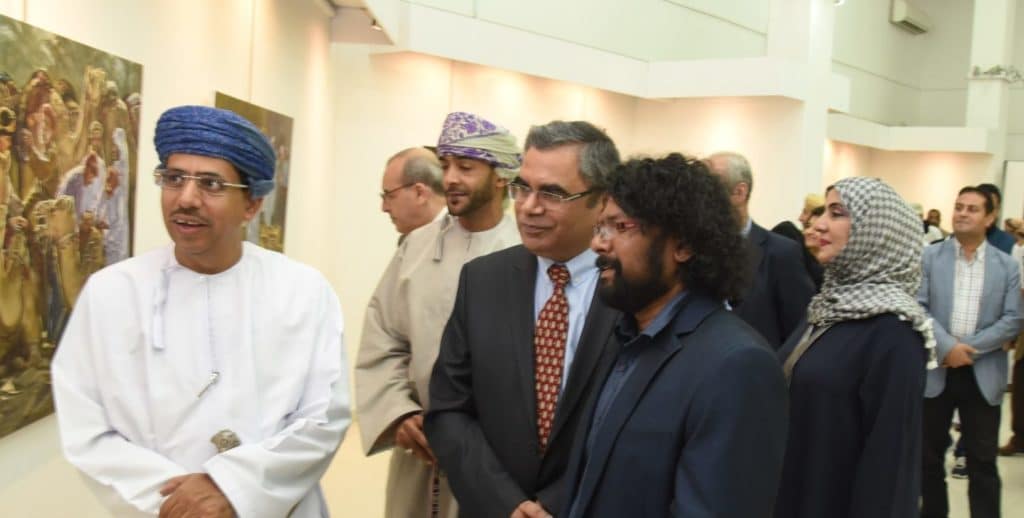Not long after Sedunath Prabhakar’s works were exhibited at the Victoria Parliament in Australia, the painter is now showing his creations in Oman to commemorate the bilateral relations between India and the Gulf nation. The exhibition, being held by the Indian Embassy in Muscat to honor Oman’s 47th National Day, included portraits and paintings of the two countries.
Prabhakar strongly feels there is a need to build bridges between different countries and cultures, and seeks to do his bit through his art. While his works displayed in Australia earlier this year drew from the common British heritage of both the countries, the current show in Oman is inspired from its ancient relationship with India, of sharing handicrafts, clothes and ornaments. “As an artist, the bonding with similar nature and human history inspired me,” the 43-year-old Melbourne-based painter tells Little India.
“India and Australia were British colonies. I feel that BR Ambedkar in India and Eddie Mabo in Australia could have shared the same feelings in their personal life as well as in their social political interpretation,” he adds, talking about his exhibition for the Victoria Parliament, which included paintings of 50 famous Australians like Donald Bradman, first woman Prime Minister Julia Gillard, explorer Captain James Cook, John Monash (Army Commander who took part in the First World War), Nobel Prize winning writer Patrick White, aboriginal artist Emily Kame Kngwarreye, swimmer Ian Thorpe, and footballer Tim Cahill.
Prabhakar, who moved to Melbourne in 2008, has come a long way from his days as an aspiring artist born in a conservative family in Kerala. He was interested in art since the age of 4 but his family was not familiar with the arena and did not encourage him to pursue his passion. Even though he belonged to a middle class family he worked part-time to be able to study art, and participated in exhibitions in Gujarat, Delhi and Kerala.
He moved to Australia without any contacts in the fraternity, and no clue about where to begin his creative journey. During the first two years of his stay in the country, no art gallery accepted his work. “It is the hardest part in the journey of every artist who is from a country like India,” says the artist whose preferred medium is oil on canvas. “It means there still is discrimination going on against people of color or if you are from a third world country.”
Then he met Sister Rosmina, an Australian nun and artist.
“She was so impressed with my work,” Prabhakar recalls. “She gave me all of her art properties and motivated me all the time. One day, I presented her a portrait that I made. She received it but gave it back and told me to keep it.” Prabhakar didn’t know then that she was terminally ill with cancer. “Her colleague told me that during her last breath she uttered my name,” he says. “Now, I am planning to establish an international gallery in her name in Australia.”
Prabhakar, who is also a writer and singer, runs six centers for art and Carnatic music in Australia, the first of which came up in 2010. Over 150 people now come to the institute, a sign, he says, of the interest people have in multicultural activities in Australia.
“I encourage my students to participate in multicultural programs rather than their own community programs. It helps them open a wide door to the world,” he adds, talking about how people are generally multi-talented. “Most people, in their attempt to become obedient citizens, lock up their talents,” he explains, saying that he feels no distinction between his works of art, classical music, writing and martial arts. “When we distinguish and touch the inner thread of art, we are free to play with them. That is why I feel free to approach any art form.”
Prabhakar also believes that artists are involved with society only indirectly. “They extract from the absolute nature of an object or thought. Look at Guernica by Picasso. He did not use any primary colors. Instead, he used the color of ash and the painting has come an anti-war symbol forever,” he says, about an artist’s need to look within. “There is only one way to overcome a block, try to be more of what you are. I take my brush, sing a raga…and that is enough.”
(Sedunath Prabhakar’s artworks are at display at the Omani Society for Fine Arts at Muscat from Nov. 7 to 13)
